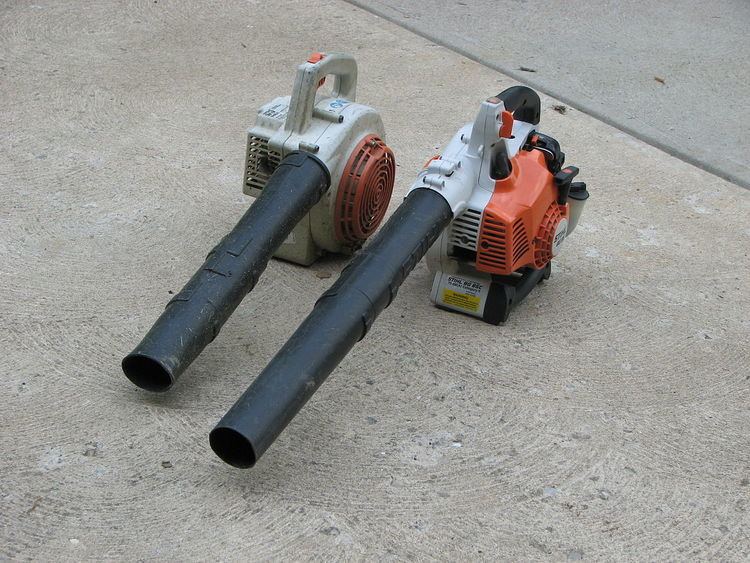 | ||
A leaf blower (often referred to as simply a blower) is a gardening tool that propels air out of a nozzle to move debris such as leaves and grass cuttings. Leaf blowers are powered by electric or gasoline motors. Gasoline models have traditionally been two-stroke engines, but four-stroke engines were recently introduced to partially address air pollution concerns. Leaf blowers are typically self-contained handheld units, or backpack mounted units with a handheld wand. The latter is more ergonomic for prolonged use. Larger units may rest on wheels and even use a motor for propulsion. These are sometimes called "walk behind leaf blowers" because they must be pushed by hand to be operated.
Contents
Some units can also suck in leaves and small twigs via a vacuum, and shred them into a bag. In that role it is called a blower vac.
Overview
The leaf blower was invented by Dom Quinto in the late 1950s. It was originally introduced to the United States as part of an agricultural chemical sprayer. Shortly thereafter manufacturers discovered that many consumers were removing the chemical dispensing parts from the device, leaving only the blower behind. Manufacturers then saw the potential of their invention as a common lawn and garden maintenance tool. Drought conditions in California facilitated acceptance of the leaf blower as the use of water for many garden clean-up tasks was prohibited. Leaf blowers also save time compared to a broom. By 1990, annual sales were over 800,000 in the U.S., and the tool had become a ubiquitous gardening implement.
Other functions beyond the simple use of garden maintenance have been demonstrated by Richard Hammond on the Brainiac television series, in which a man sized hovercraft was constructed from a leaf blower. Being both portable and able to generate wind speeds of between 140–270 miles per hour (63–121 m/s) and air volumes of 14 m3 per minute, the leaf blower has many potential uses in amateur construction projects.
Environmental impact
Emissions from gasoline-powered grounds-keeping equipment in general are a source of air pollution and more immediately (when powered by internal combustion engines, rather than by electricity), noise pollution. In the United States, US emission standards prescribe maximum emissions from small engines.
In addition to the adverse health effects of carbon monoxide, nitrogen oxides, hydrocarbons, and particulates generated in the exhaust gas of the gasoline-powered engines, leaf blowers pose problems related to dust raised by the powerful flow of air. Dust clouds caused by leaf blowers contain potentially harmful substances such as pesticides, mold, and animal fecal matter that may cause irritation, allergies, and disease.
Noise pollution is also a concern with leaf blowers, as they emit noise levels well above those required to cause hearing loss to both the operator and those nearby. Soon after the leaf blower was introduced into the U.S., its use was banned in two California cities, Carmel-by-the-Sea in 1975 and Beverly Hills in 1978, as a noise nuisance. There are currently twenty California cities that have banned leaf blowers, sometimes only within residential neighborhoods and usually targeting gasoline-powered equipment. Another 80 cities have ordinances on the books restricting either usage or noise level or both.
